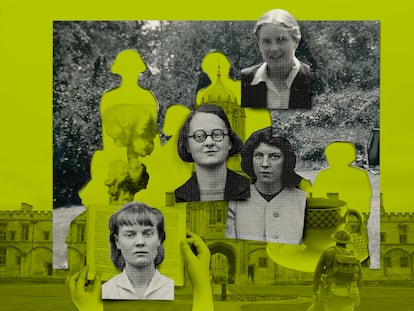Georges Didi-Huberman, art theorist: ‘In Israel and Gaza we have fascists against fascists’
The philosopher and French art historian has written 60 essays. He is a specialist on the use of images in contemporary culture and looks for the surprises hidden within them, like children do
Georges Didi-Huberman (Saint-Étienne, 1953), philosopher and French art historian, is an expert on the use and significance of images in contemporary culture in ethical, political and symbolic dimensions. He has written 60 essays on the subject, including texts on our conception of madness (The invention of hysteria: Charcot and the photographic iconography of the Salpêtrière), on the importance of viewing the images of the cremation of Jews as captured by a Sonderkommando worker, one of the prisoners who had the task of bringing fellow humans to their “final solution” (Images despite everything: A visual memory of the Holocaust), the importance of our actions during social revolts (in the exhibition Soulèvements [Uprisings]) and even on the rupturist choreographies of Seville’s National Dance Prize-winner Israel Galván (El bailaor de soledades [The flamenco dancer of loneliness]). His last book, Imaginar. Recomenzar [Imagine. Start again] (Abada Editores, May 2023), delves into the anthropology of the political imagination.
On November 21, he was featured at a Madrid gathering that formed part of the Condeduque Center of Contemporary Culture’s Pensamiento event series, Images, ways of looking and thinking, on a subject near and dear to his heart. Hours later, in the lobby of his hotel, he asked to be photographed in a different chair (the original one was too pompous). He proved to be cutting, full of sharp edges, but also of ideas.
Question. There is something about the art world’s norms that does not sit well with you. You believe that it should open itself up to other perspectives.
Answer. Discourse in art has a long history, it’s tradition. My aim is not to disengage from tradition. For me, the key lies in rising above conformity. Questioning something does not mean that you consider everything that came before to be obsolete. Nothing is obsolete. But when a tradition fossilizes and becomes conformist, that’s problematic. I’m interested in making another reading of diverse subjects, coming to this process as a child would, detaching them from conformism.
Q. You say that “rereading is a political act.”
A. What did Lacan say? I reread Freud. Deleuze? I reread Spinoza and Nietzsche. I reread the pursuit of novelty. I recommend Miguel Abensour, who led me to rediscovering Marx. We still haven’t exhausted Plato!
Q. What is an image, for you?
A. An image is never unique, your question is poorly planted. It’s always one among many. What counts is its place in the series. There is no onthology of an image. My position is quite modest, I look at two or three photographs and try to deduce something concrete. I decline to respond to the question.
Q. I’ll rephrase it: what do you look at when you look at a series of images?
A. That like me asking you what you expect from a person. If you’re looking for something specific, you can go to a dating app so you can find out if they like running, horseback riding… No, what you expect from someone is a surprise. We live amidst an excess of images, but when you come across one the process is the same as with a person, we look for the unexpected. That’s what I’m looking for. Feeling, escape from conformity.
Q. In Condeduque you said that as human beings we often steer towards beauty because we are afraid, because of our rejection of the world’s horror.
A. If you visit the Prado to admire Botticelli, you will find a man behind a woman who has opened her skin with a knife, who tears out her heart and feeds it to a dog. When we look at images, we realize that their beauty is made with the horror of the world, and that that which attracts us and repels us are always intermingled in art. Another example is Goya. Goya, is he beautiful or not?
Q. You’ve also said that political imagination was born with Goya.
A. One must never say that something was born in an exact moment. But if you compare Los desastres de la Guerra [The disasters of war] by Goya with Las grandes miserias de la guerra [The great miseries of war] by Jacques Callot, we find that Callot represented horror from afar. Goya gets in as close as possible, like Capa, he presents a new essential form for relating to violence, of representing it. Like Kant, Goya makes his critique through image. What we need is to succeed in critique. We must not be conformist and we must not reject. Critique is very difficult. A philosopher always tries to critique with justice.
Q. You defended in an essay the exhibition of the terrible images of the cremation of innocents taken by a member of a Sonderkommando, the prisoners who were made to apply the final solution to other Jews. With Israel’s invasion of Gaza, this is a debate currently confronting the media. Should we show reality in all its rawness?
A. When we show something, we never should do so without context. There is an attempt to explain or sensitize to the gaze of the person who took the photograph. There are bastard gazes, tender gazes… But I don’t know the photographs you are talking about. I have not seen the images of the Hamas attack.
Q. But perhaps you’ve seen those of the attacks on Gaza.
A. A priori, I am never in favor of censorship. But it is a recurring error to not take into account the circumstances that had led up to that image.
Q. You are Jewish. What is your opinion of Israel’s actions in Gaza?
A. The Israeli government is a government run by crazy fascists. Fascism has invested in the Israeli government. Notice that I am not saying the Israelis. The state of Israel is in danger, that’s true. Hamas is a fascist militia, so in essence what we have is fascists against fascists and, in between, the people. It is a deadly showdown and I fear as much for one side as for the other. I don’t dare to sign petitions… But allow me to point out that a philosophic view of this is of zero interest. Today it is commonplace for intellectuals to be asked to give their opinion on everything, they are given this enormous power, one that is too great. Don’t you find it strange asking an art historian for his opinion on the war between Gaza and Israel?
Q. You mentioned the fascist emotion. What does that involve?
A. I’ll give you a real example: a German listens to Hitler and becomes emotional, their emotion is political. One year later, he unfeelingly kills babies. What has happened? The emotion of this young Nazi has become dissociated from the experience of others. He cares only for his own. He has lost a sense of ethics. That is where fascism is built. Trump is emotional, Milei, Le Pen… Emotions, but dissociated from everything else.
Q. They say: “Tenderness opens doors.”
A. Tenderness is reaching out a hand to someone. A man who is a politician will say that what he talks about is completely utopic. But utopia plays a necessary political role. One must defend it. It is never achieved, but it sets us down the road.
Sign up for our weekly newsletter to get more English-language news coverage from EL PAÍS USA Edition
Tu suscripción se está usando en otro dispositivo
¿Quieres añadir otro usuario a tu suscripción?
Si continúas leyendo en este dispositivo, no se podrá leer en el otro.
FlechaTu suscripción se está usando en otro dispositivo y solo puedes acceder a EL PAÍS desde un dispositivo a la vez.
Si quieres compartir tu cuenta, cambia tu suscripción a la modalidad Premium, así podrás añadir otro usuario. Cada uno accederá con su propia cuenta de email, lo que os permitirá personalizar vuestra experiencia en EL PAÍS.
¿Tienes una suscripción de empresa? Accede aquí para contratar más cuentas.
En el caso de no saber quién está usando tu cuenta, te recomendamos cambiar tu contraseña aquí.
Si decides continuar compartiendo tu cuenta, este mensaje se mostrará en tu dispositivo y en el de la otra persona que está usando tu cuenta de forma indefinida, afectando a tu experiencia de lectura. Puedes consultar aquí los términos y condiciones de la suscripción digital.
More information
Archived In
Últimas noticias
Welcome to the post-religion era: The idea of Christianity as the absolute truth has become obsolete
‘I thought you would like it’: The risky sexual practice popularized by TV shows and TikTok
The digitalization of tourism: ‘They promise experiences and gave us the worst possible one’
Mexican peso defies uncertainty with forecasts of a new period of stability in 2026
Most viewed
- Sinaloa Cartel war is taking its toll on Los Chapitos
- Reinhard Genzel, Nobel laureate in physics: ‘One-minute videos will never give you the truth’
- Oona Chaplin: ‘I told James Cameron that I was living in a treehouse and starting a permaculture project with a friend’
- Why the price of coffee has skyrocketed: from Brazilian plantations to specialty coffee houses
- Silver prices are going crazy: This is what’s fueling the rally











































